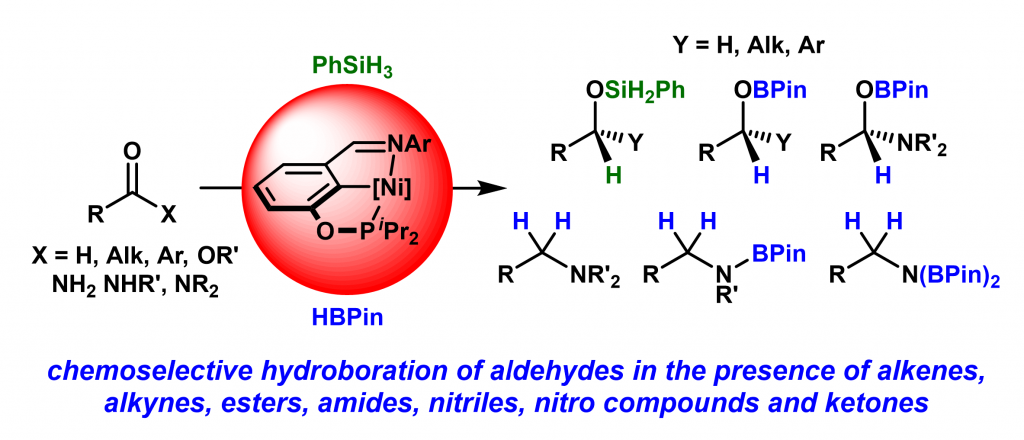
Research Interest
Research interests:
Homogeneous catalysis for sustainable chemical and energy technologies
Activation of small molecules by transition metal complexes for their conversion into liquid fuels and chemical feedstock
Development of new abundant metal catalysts for chemo-, regio-, and enantioselective transformation of organic substrates into value-added products
Organometallic approaches to solar energy harnessing
Dr. Andrey Khalimon received his Dipl. Chem. Degree (Diploma with Excellence) from M. V. Lomonosov Moscow State University (Russia) in 2004 and Ph.D. in Inorganic Chemistry from Brock University (Canada) in 2010. His doctorate work with Prof. Georgii I Nikonov was focused on the investigation of new catalytic methods and design of novel early transition metal catalysts for reduction of challenging substrates. This included detailed mechanistic studies of catalytic reactions in order to make even better system with desired properties.
After his Ph.D., he joined the group of Prof. Warren E. Piers at the University of Calgary (Canada) as a Postdoctoral Research Associate, where he continued to work in the field of transition metal catalysis (photoinduced olefin metathesis) and materials chemistry (the development of Photo Lewis Acid Generators and their applications in advanced photolithography) in collaboration with the Intel Corporation (USA).
In 2013, Dr. Khalimon moved to Heidelberg in Germany and joined CaRLa (Catalysis Research Laboratory, BASF SE) as a Post-Doctoral Research Fellow. Working as a part of the team of industrial and fundamental chemists, he was involved in the development of the first catalytic system for direct synthesis of acrylates from CO2 and olefins – a highly attractive process for chemical industry.
Dr. Khalimon joined Nazarbayev University as faculty member in January 2015.
Dr. Khalimon’s current research is mainly focused on the chemistry of the first-row transition metals and covers ligand design and many theoretical, synthetic and structural aspects of coordination and organometallic compounds. This research requires an extensive use of different physicochemical and spectroscopic techniques for characterization of transition metal complexes and study their properties and reactivity. A large part of his group research is devoted to understanding the reactivity of metal complexes and the mechanisms of catalytic reactions in order to develop even better systems with predictable properties and reactivity patterns.
Current research projects include:
- Development of base metal catalysts for reduction of challenging unsaturated molecules
Reduction of unsaturated organic molecules is one of the most fundamental transformations in organic synthetic chemistry relevant to production of both commodity and fine chemical products. Whereas stoichiometric reduction reactions often require the use of rather strong reductants and, therefore, have associated selectivity issues, catalytic reductions by means of (transfer) hydrogenation, hydrosilylation and hydroboration present more atom economic and selective alternatives to conventional stoichiometric methods. Similarly with many other homogeneous catalytic transformations, the conventional catalytic systems for reduction reactions are mostly based on precious metals, the 2nd and 3rd row elements of groups 8-10. Due to the skyrocketing prices of these elements one of the attractive research venues in this area is transferring the reactivity of such catalysts to more economical and “greener” first-row (3d) metal surrogates, those involving so called base-metals: Fe, Co, Ni and Mn. Our group is interested in development of such well-defined catalytic systems based on non-precious metals with precious-metal-like reactivity and their applications in chemo-, regio- and stereoselective reduction of challenging (deactivated) unsaturated organic substrates and carbon dioxide.
Recent references:
- Nurseiit, A.; Janabel, J.; Gudun, K. A.; Kassymbek, A.; Segizbaev, M.; Seilkhanov, T. M.; Khalimon, A. Y. Bench‐Stable Cobalt Pre‐Catalysts for Mild Hydrosilative Reduction of Tertiary Amides to Amines and Beyond. ChemCatChem 2019, 11, 790‐798. link

- Gudun, K. A.; Segizbayev, M.; Adamov, A.; Plessow, P. N.; Lyssenko, K. A.; Balanay, M. P.; Khalimon, A. Y. POCN Ni(II) pincer complexes: synthesis, characterization and evaluation of catalytic hydrosilylation and hydroboration activities. Dalton Transactions 2019, 48, 1732‐1746. link

- Segizbayev, M.; Öztopçu, Ö.; Hayrapetyan, D.; Shakhman, D.; Lyssenko, K. A.; Khalimon, A. Y. Transfer Hydrogenation of Aldehydes and Ketones Catalyzed using an Aminophosphinite POCNH Pincer Complex of Ni(II). Dalton Transactions 2020, 49, 11950-11957. link

- Base metal catalysts for interconversion of N-containing organic functional groups
Amines and other N-containing organic molecules represent synthetically important classes of compounds, relevant to preparation of many commodity and fine chemicals, synthesis of biologically active molecules andnatural products, pharmaceuticals, agrochemicals, functional materials and so on. The conventional stoichiometric methods for preparation of amines and their conversion to more complex N-containing organic molecules as well as methods for interconversion of N-containing functional groups often suffer from lack of selectivity, control and functional group tolerance and lead to formation of large amounts of byproducts. On the other hand, the majority of catalytic methods developed for such transformations are based on expensive precious metals and the reactions often require rather harsh conditions, such as high temperatures and long reaction times. We are interested in development of simple and efficient base metal catalysts for mild and selective synthesis of amines from readily available primary industrial chemicals and for interconversion of different N-containing functional groups and application of this strategy for synthesis of more complex value-added nitrogen-containing organic molecules.
Recent references:
- Gudun, K. A.; Slamova, A; Hayrapetyan, D.; Khalimon, A. Y. Efficient Co‐catalyzed Double Hydroboration of Nitriles: Application to One‐Pot Conversion of Nitriles to Aldimines. Chemistry – A European Journal 2020,26, 4963-4968.link

- Base metal materials for wastewater treatment
Using the knowledge acquired from homogeneous catalysis, this project aims at the development of base metal composite materials and heterogenized catalysts (using titanium dioxide, surface modified silica and other supports) for catalytic removal of organic pollutants (for instance, chlorinated hydrocarbons, nitrophenols, etc.) from industrial wastewaters. We are also interested in application of such materials in catalytic conversion of carbon dioxide to liquid fuels.
- Design of complexes with polyaromatic ligands for photocatalytic and electrocatalytic applications
Polyaromatic ligands play an important role in coordination/organometallic compounds for solar energy harnessing and catalysis, including catalysts with non-innocent redox active ligands. We are interested in design of polyaromatic polydentate ligands based on strongly absorbing chromophores, preparation of their transition metal complexes, investigation of photophysical and photochemical properties of such complexes and their application in photoinduced catalytic reactions and electrocatalysis for reduction of carbon dioxide, production of hydrogen from water and many other processes.
For more information visit Khalimon research group website: https://www.khalimon-group.com/
Selected Publications:
- Adilkhanova, A.; Frolova, V. F.; Yessengazin, A.; Öztopçu, Ö.; Gudun, K. A.; Segizbayev, M.; Matsokin, N. A.; Dmitrienko, A,; Pilkington, M.; Khalimon, A. Y. “Synthesis and Catalytic Performance of Nickel Phosphinite Pincer Complexes in Deoxygenative Hydroboration of Amides” Dalton Trans. 2023, DOI: 10.1039/D2DT03801C. link
- Gudun, K. A.; Tussupbayev, S.; Slamova, A.; Khalimon, A. Y. “Hydroboration of Isocyanates: Cobalt-Catalyzed vs. Catalyst-Free Approaches” Org. Biomol. Chem. 2022, 20, 6821-6830. link
- Gudun, K. A.; Zakarina, R.; Segizbayev, M.; Hayrapetyan, D.; Slamova, A.; Khalimon, A. Y. “Cobalt-Catalyzed Deoxygenative Hydroboration of Nitro Compounds and Applications to One-Pot Synthesis of Aldimines and Amides” Adv. Synth. Catal. 2022, 364, 601-611. link
- Baidilov, D.; Hayrapetyan, D.; Khalimon, A. Y. Recent Advances in Homogeneous Base-Metal-Catalyzed Transfer Hydrogenation Reactions. Tetrahedron 2021, 98, 132435 (contribution to the special issue “Sustainable Catalysis”). link
- Segizbayev, M.; Öztopçu, Ö.; Hayrapetyan, D.; Shakhman, D.; Lyssenko, K. A.; Khalimon, A. Y. Transfer Hydrogenation of Aldehydes and Ketones Catalyzed using an Aminophosphinite POCNH Pincer Complex of Ni(II). Dalton Trans. 2020, 49, 11950-11957. link
- Hayrapetyan, D.; Khalimon, A. Y. Catalytic Nitrile Hydroboration: A Route to N,N-Diborylamines and Uses Thereof. Chem. Asian J. 2020, 15, 2575-2587. link
- Gudun, K. A.; Slamova, A; Hayrapetyan, D.; Khalimon, A. Y. Efficient Co‐catalyzed Double Hydroboration of Nitriles: Application to One‐Pot Conversion of Nitriles to Aldimines. Chem. Eur. J. 2020, 26, 4963-4968. link
- Khalimon, A. Y.; Gudun, K. A.; Hayrapetyan, D. Base Metal Catalysts for Deoxygenati e Reduction of Amides to Amines. Catalysts 2019 9, 490 (contribution to the special issue “Coordination Chemistry and Catalysis”). link
- Gudun, K. A.; Segizbayev, M.; Adamov, A.; Plessow, P. N.; Lyssenko, K. A.; Balanay, M. P.; Khalimon, A. Y. POCN Ni(II) pincer complexes: synthesis, characterization and evaluation of catalytic hydrosilylation and hydroboration activities. Dalton Trans. 2019, 48, 1732‐1746. link
- Nurseiit, A.; Janabel, J.; Gudun, K. A.; Kassymbek, A.; Segizbaev, M.; Seilkhanov, T. M.; Khalimon, A. Y. Bench‐Stable Cobalt Pre‐Catalysts for Mild Hydrosilative Reduction of Tertiary Amides to Amines and Beyond. ChemCatChem 2019, 11, 790‐798. link
- Khalimon, A. Y.; Farha, P. M.; Nikonov, G. I. Imido‐hydrido Complexes of Mo(IV): Catalysis and Mechanistic Aspects of Hydroboration Reactions. Dalton Trans. 2015, 44, 18945‐18956. link
- Khalimon, A. Y.; Shaw, B. K.; Marwitz, A. J. V.; Piers, W. E.; Blackwell, J. M.; Parvez, M. Photo Lewis acid generators: Photorelease of B(C6F5)3 and applications to catalysis. Dalton Trans. 2015, 44, 18196‐18206. link
- Khalimon, A. Y.; Leitao, E. M.; Piers, W. E. Photogeneration of a Phosphonium Alkylidene Olefin Metathesis Catalyst. Organometallics 2012, 31, 5634‐5637. link
- Khalimon, A. Y.; Piers, W. E.; Blackwell, J. M.; Michalak, D. J.; Parvez, M. A Photo Lewis Acid Generator (PhLAG): Controlled Photo Release of B(C6F5)3. J. Am. Chem. Soc. 2012, 134, 9601‐9604. link
- Khalimon, A. Y.; Simionescu, R.; Nikonov, G. I. Catalytic and Stoichiometric Reactivity of β-Silylamido Agostic Complex of Mo: Intermediacy of a Silanimine Complex and Applications to Multicomponent Coupling. J. Am. Chem. Soc. 2011, 133, 7033‐7053. link
For a complete list of publications, see: Scopus, Google Scholar, Khalimon group
Spring 2024
- CHEM 380 – Research Methods
- CHEM 451 – Applied Homogeneous Catalysis
- CHEM 532 – Organometallic Chemistry
- CHEM 550 – Selected Topics in Chemistry
- CHEM 780 – Research Methods and Ethics
Fall 2023
- CHEM 350 – Advanced Inorganic Chemistry
- CHEM 530 – Inorganic Structures and Reaction Mechanisms
- CHEM 750 – Modern Inorganic Chemistry
- CHEM 591 – Scientific Methods in Chemistry (team-taught course)
- CHEM 700 – Hot Topics in Chemistry (team-taught course)
Summer 2023
- CHEM 189c – Independent Study
- CHEM 560 – Directed Research in Chemistry
Spring 2023
- CHEM 380 – Research Methods
- CHEM 451 – Applied Homogeneous Catalysis
- CHEM 550 – Selected Topics in Chemistry
- CHEM 753 – Organometallic Catalysis
Fall 2022
- CHEM 350 – Advanced Inorganic Chemistry
- CHEM 530 – Inorganic Structures and Reaction Mechanisms
- CHEM 750 – Modern Inorganic Chemistry
Summer 2022
- CHEM 560 – Directed Research in Chemistry
Fall 2021
- CHEM 350 – Advanced Inorganic Chemistry
- CHEM 350L – Advanced Inorganic Chemistry Lab
- CHEM 530 – Inorganic Structures and Mechanisms
Summer 2021
- CHEM 189c – Independent Study
Spring 2021
- CHEM 380 – Research Methods
- CHEM 451 – Applied Homogeneous Catalysis
- CHEM 550 – Selected Topics in Chemistry



